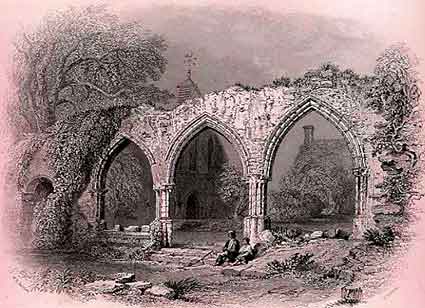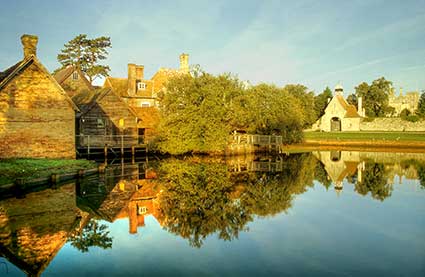Beaulieu history - an introduction

shown in a 19th century print
Beaulieu Abbey (A)
Beaulieu's recorded history starts with the creation of Beaulieu Abbey, for it was around the Abbey that the village clustered. Founded in 1204 on land given by King John, Beaulieu Abbey was built for Cistercian monks whose order originated in France in 1098.
But for the monks, Beaulieu Abbey life was to come to an abrupt end in 1538 when Henry VIII brought major religious houses into private ownership.
The inner Great Gatehouse, however, was converted, extended and rebuilt to become Palace House, whilst the Choir Monks' Refectory became Beaulieu's parish church that is still in use to this day.
St. Leonard's Barn, Grange and Chapel (B)
Impressive evidence of the Beaulieu Abbey lay brothers' farming endeavours can be seen at St Leonard's, 6 kilometres (3¾ miles) south-east of Beaulieu, where the ruins of an enormous 13th or 14th century barn stand by the roadside.
Thought to be one of the largest in England, it was 210 feet long and 70 feet wide, and had a capacity of ½ million cubic feet. Nearby, and of similar age, are St. Leonard's Grange, now much modified; and the ruins of St. Leonard's Chapel.
(None of these are open to the public but can be readily seen from the adjacent minor road).
Sowley Pond (C)
Also situated around 6 kilometres from Beaulieu, Sowley Pond owes its existence to Beaulieu Abbey monks who dammed two small streams to create a fish-pond.
Nowadays a haven for wildlife, the peace and quiet is broken only by the occasional car on the adjacent minor road, but it was not always so, for an ironworks operated nearby from the early 17th to the early 19th centuries, using water from the pond to power blast furnace bellows.
(Sowley Pond is visible from the minor road, but there is no public access).
Beaulieu Mill (D)

leading to Buckler's Hard
Beaulieu Mill was also powered by water, in this case, though, supplied by the incoming tide and the outflow back to sea from the nearby mill pond - the Mill Dam - which was created specially for the purpose by Abbey monks.
Located on Beaulieu Bridge, corn continued to be ground here until the early years of the 20th century, after which the mill was used to produce animal feeds until around 1942.
Beaulieu village (D)
The Montagu Arms Hotel is close to the mill. An original inn on this site dated back to the 16th century, when it was known first as The Ship, and then The George. The old building had been replaced by the 18th century, and in 1742 took the current name.
The late 18th century Richardson, King and Driver map of Beaulieu shows a village remarkably similar in layout to that of today, except, of course, for the modern by-pass that enables through traffic to avoid the narrow High Street where a timeless array of mainly 17th, 18th and 19th century richly mellow, brick-built properties line the road.
Buckler's Hard (E)

(Copyright: Charlotte Leaper)
Buckler's Hard, a tiny hamlet on the western bank of the Beaulieu River, lies 3.25 kilometres (2 miles) downstream from Beaulieu village.
Originally conceived in the first half of the 18th century as Montagu Town, by John, 2nd Duke of Montagu, it was to be a base for ship-building, and a landing place and refinery for sugar imported from West Indian plantations.
But the sugar venture failed and the would-be port was eventually taken over by Henry Adams who there built many of the great wooden ships of the day.
(To reach Buckler's Hard, the energetic with time to spare can enjoy a pleasant walk or cycle ride from Beaulieu village along a section of the Solent Way - full route details are here).
The Beaulieu River - an attractive natural asset
The tidal stretches of the Beaulieu River provided water power to drive the wheels of Beaulieu Mill, brought ship-building to the neighbourhood, and made available fish and fowl for sport and the table.
But that's not all, for place names strongly suggest that salterns were present a little downstream from Buckler's Hard, places where salt was extracted from the water by a process of evaporation - even today, modern maps show Saltershill and Saltershill Copse, whilst across the river at Exbury is Salterns Copse. (There is lots more information about some of the Solent salterns here - Lymington Salterns).
Oysters, too, were cultivated locally, in beds constructed in around 1879 a little to the south of Buckler's Hard. Sadly, though, for the owners and workers, but maybe not for the oysters, disappointing sales and high production costs had forced closure by 1906.
And, of course, the river has provided a means of transport and the basis for ever popular leisure activities - as long ago as 1894 the Gosport Steam Launch Company began running day excursions by boat to Buckler's Hard.
Two airfields
The sites of two airfields are very close to the Beaulieu parish boundary, although both are within the bounds of East Boldre parish. The first, East Boldre Airfield, started life as the home of the New Forest Aviation School and shortly after was used as a First World War pilot training airfield. The second, RAF Beaulieu (or Beaulieu Airfield, as it is sometimes known), has its roots anchored deeply in the annals of the Second World War.
Both made invaluable contributions to the nation's war efforts.
Find out more about the fascinating history of Beaulieu and surrounding area
References:
Monasteries in the Landscape: Professor Mick Aston
A Guide to the New Forest: Heywood Sumner
The King’s England: Arthur Mee
Hampshire Industrial Archaeology: Southampton University Industrial Archaeology Group
Beaulieu Estate: Beaulieu Mill, Consultants Report
An Album of Old Beaulieu and Buckler’s Hard: Susan Tomkins
Hampshire Treasures
Tudorplace
More links
Other related links
Search this site

Sadly, 58 animals were killed - 35 ponies, 13 cows, 8 donkeys and 2 sheep, whilst a further 32 were injured - 3 pigs, 9 donkeys, 11 cows and 9 ponies.
(Forty-three accidents occurred in daylight, 15 at twilight and 101 in the dark. Twenty-seven accidents were not reported by the driver involved).
Here's just one horrific example - Three donkeys killed in collision with van at notorious New Forest blackspot (Advertiser and Times)
Sika deer continue to engage in rutting behaviour, and will do so until December.
Pigs seek out the remains of the acorn crop.
Beech leaves are transformed into a magnificent mosaic of glorious reds and golds. Other deciduous trees, too, take on an autumnal cloak before their leaves fall.
Dragonflies can occasionally be seen on the wing on bright days early in the month.
December
Foxglove leaves survive the winter at ground level, and offer the prospect of colourful summer blooms to come.
Redwings and fieldfares, autumn and winter visitors, gorge on haws and holly berries.
Great grey shrikes and hen harriers hunt over the heaths and other open spaces.
Honeysuckle by the end of the month often shows welcome signs of new growth.



